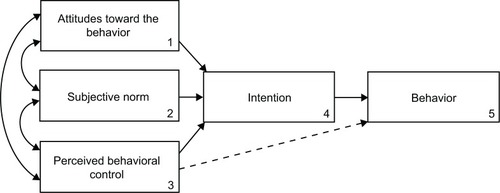Notes: Adapted from Organizational Behavior and Human Decision Process: Ajzen I. The theory of planned behavior. 1991;50(2):179–211. Copyright © 1991, with permission from Elsevier.
Citation9 The components of the Theory of Planned Behaviour concept are defined as: (
1) Attitudes toward the behavior: an individual’s positive or negative evaluation of self-performance of the particular behavior. The concept is the degree to which performance of the behavior is positively or negatively valued. It is determined by the total set of accessible behavioral beliefs linking the behavior to various outcomes and other attributes. The individual’s beliefs about the potential results of a particular behavior, based on the subjective probability that the behavior will produce a given outcome. (
2) Subjective norm: an individual’s perception of social normative pressures, or relevant others’ beliefs that he or she should or should not perform such behavior. The individual’s perception about the particular behavior, which is influenced by the judgment of significant others (parents, spouse, friends). (
3) Perceived behavioral control: an individual’s perceived ease or difficulty in performing the particular behavior, determined by the total set of accessible control beliefs. An individual’s beliefs about factors that may facilitate or inhibit performance of the behavior. (
4) Intention: an indication of an individual’s readiness to perform a given behavior based on attitude toward the behavior, subjective norm, and perceived behavioral control, with each predictor weighted for its importance in relation to the behavior and population of interest. (
5) Behavior: an individual’s observable response in a given situation with respect to a given target. It is considered a function of compatible intentions and perceptions of behavioral control in that perceived behavioral control is expected to moderate the effect of intention on behavior, such that a favorable intention produces the behavior only when perceived behavioral control is strong.

